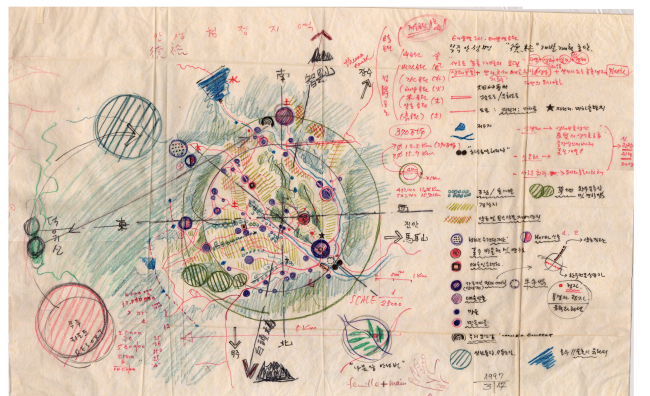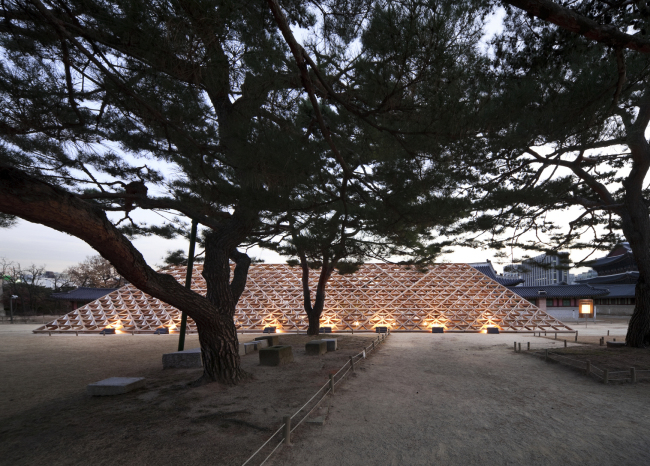우리 주변에 건축전시를 보는건 흔치 않은 일이다. 이는 아마도 건축은 예술이라는 주제보다는 기술에 더 가까운 이미지 때문일 것이다.
그러나 최근 국립현대미술관과 학고재 갤러리에서 건축전시를 열어 주목을 받고 있다.
두 곳에서는 아티스트로 활동한 경험을 갖고 있는 건축가들의 독특한 건축세계를 조망하고 있다.
먼저 국립현대미술관에서는 2년전에 작고한 정기용 건축가의 건축과 삶의 모습을 조망하고 있다.
이번 전시는 정기용 건축가가 작고 직전 국립현대미술관에 기증한 약 2만점의 자료들을 바탕으로 1년간 연구하여 구축된 정기용 아카이브 2천여점이 선별 공개된다.
 |
무주 안성면 덕유 개발개획, 마스터플랜, 1997 (국립현대미술관) |
또 다른 건축 전시는 건축가, 디자이너, 아트디렉터로서 다방면으로 활동하고 있는 김백선의 개인전이다. 동양화를 전공한 김백선은 정규 건축 교육을 받지 않고서도 한국에서 가장 한국적인 공간을 디자인하는 건축가로 알려져있다. 이번 학고재 갤러리에서 열리는 전시에서는 김백선이 그간 진행해온 영상, 사진, 설치작품 및 동양화를 전공한 작가의 이력이 돋보이는 수목화를 선보인다.
 |
김백선, 드로잉 (학고재) |
 |
김백선, 화풍: 경복궁으로의 초대, 2009, 경복궁, 서울 (남궁선/학고재) |
(코리아헤럴드 이우영 기자 )
<관련 영문 기사>
Galleries show work of ‘uncommon’ architects
Two exhibitions focus on the late architect Chung Gu-yon and multi-talented architect/artist Kim Paik-sun
With architecture more commonly associated with engineering than art, exhibitions devoted to architects are still rare.
But two exhibitions in Seoul focus on architects whose background as artists gave them a unique approach.
The exhibition at the National Museum of Contemporary Art, Korea sheds light on the life of Chung Gu-yon, who died of cancer in 2011.
The first public exhibition of the archives of Chung since his death features about 2,000 items including his sketches, journals and books that inspired him.
Most of the items on display consist of Chung’s sketches that capture the essence of the ideals of his architecture and 29 years of practice that strived to meet them.
The sketches show Chung’s endeavor as “a designer, not as a problem-solver, but someone who looks into people’s lives and organizes their lives” as he said in the recent documentary film on him, “Talking Architect.”
His drawings are not merely about building designs, but also the surrounding land and nature that modern architects often overlook.
When most Koreans during the 1980s and 90s viewed houses as a means for investment, Chung reminded them of the original meaning of living in his designs -- including one for a rural community center, schools, funeral homes and children’s libraries.
Chung who majored in craft and fine art at Seoul National University before he studying architecture in Paris also made his drawings works of art.
A 47-year-old artist and art director, Kim Paik-sun is also a successful architect whose background is in Oriental painting. Without a formal education in architecture, Kim established a reputation as an architect who creates Korean architectural landscapes.
The multi-talented architect has put together his diverse practices in architecture, photography and ink-and-wash paintings at his solo exhibition at Hakgojae Gallery.
Despite the different media, the underlying concept is in the simple yet sophisticated Korean ink-and-wash painting.
Kim started painting when he was intrigued by an ink-and-wash painting printed on a calendar at home, and received an art award when he was in high school. He went on to study painting at the Oriental painting department of Hongik University.
“My design is based on the way I viewed the world through Korean paintings. I continued painting ink-and-wash paintings, four plants (orchid, bamboo, chrysanthemum, and plum blossom) and landscape. That’s how I developed my way of seeing things,” said Kim at a recent press meeting at Hakgojae gallery.
In his 15 years as an architect, Kim has designed several notable buildings in Seoul, such as the U.N. Village in Hannam-dong, a trendy bar in Cheongdam-dong called T-LOUND and the Korean Embassy in Denmark. He also did interior designs for the Ferrum Tower.
He made installations that cross the boundary of art and architecture, including a wooden installation space that recreates the traditional Korean culinary culture in Gyeongbokgung Palace in 2010.
Asked what qualities make him a good architect and designer, he said: “I am not bound by any fields. Architecture, art and design are fields that are defined by society. What I keep in mind is how sincere I feel toward the work I do at the time,” Kim said.
“I want my architecture to have passion and care for life. It’s homes and buildings that most people spend large portion of their life in, in the end,” Kim said.
The exhibition “Figurative Journal: Chung Guyon Archive” continues through Sept. 22 at the National Museum of Contemporary Art, Korea in Gwacheon. For more information, call (02) 2188-6000.
The Kim Paik-sun exhibition continues through March 17 at Hakgojae Gallery in Jongno, Seoul. For more information, call (02) 720-1524.
By Lee Woo-young
(wylee@heraldcorp.com)







![[Today’s K-pop] Blackpink’s Jennie, Lisa invited to Coachella as solo acts](http://res.heraldm.com/phpwas/restmb_idxmake.php?idx=644&simg=/content/image/2024/11/21/20241121050099_0.jpg)